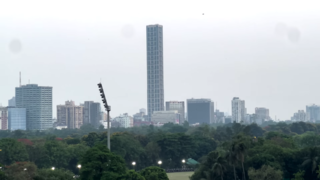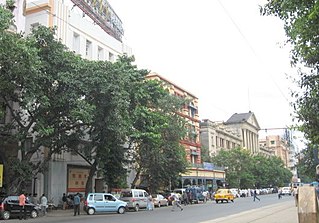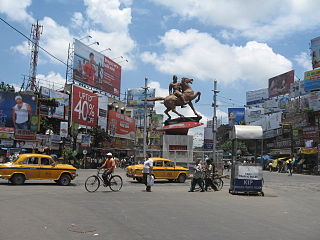
Maidan is a large urban area containing vast urban green space, parks, playgrounds and several public venues in the center of Kolkata, India. The area is spread over a total area of 1283 Acres. The urban green space of Maidan, which compromises an area of around 400 acres, is the largest urban park and urban green space in Kolkata city and second largest in the Kolkata metropolitan area as well as in India. Prior to 2013, before the creation of Eco Park it was the largest urban park in India. Its vast stretch of field that includes numerous sporting grounds, including the famous cricketing venue Eden Gardens, several football stadiums and the Kolkata Race Course.

Esplanade is a neighbourhood of Central Kolkata, in Kolkata district in the Indian state of West Bengal. This is not a conventional esplanade in the sense that the place is not exactly situated alongside a waterbody. However, the Ganga river (Ganges), also known as Hooghly river, flows nearby.

Park Street, is a famous thoroughfare in downtown Kolkata, India. In Bengali, it is often referred as Shaheb -er Para or the “neighbourhood of Englishmen”.The street runs through what was a deer park of Sir Elijah Impey, Chief Justice of the Supreme Court in Calcutta from 1773 to 1789, hence the earlier name. It's located in central part of Calcutta.

Chittaranjan Avenue, more commonly C.R. Avenue, a principal north-south thoroughfare in Central-North Kolkata. It starts from Beadon Street crossing in the north and ends at Chowringhee Road-Bentinck Street Junction (Esplanade) in the south. The road is renamed after Deshbandhu Chittaranjan Das, a nationalist politician and freedom-fighter of India. North of Beadon Street crossing, Chittaranjan Avenue becomes Jatindra Mohan Avenue.

Chowringhee is a neighbourhood of Central Kolkata, in Kolkata district in the Indian state of West Bengal. Chowringhee Road runs on its western side. A neighbourhood steeped in history, it is a business district, as well as a shopper's destination and entertainment-hotel centre. The area lies exactly at the centre of the city.

Janbazar is a neighbourhood of Central Kolkata, in Kolkata district in the Indian state of West Bengal. The two century-old house of Rani Rashmoni, the central attraction in Janbazar, is still used by descendants in the family.

Shyambazar is a neighbourhood of North Kolkata, in Kolkata district in the Indian state of West Bengal. The area, under Shyampukur police station of Kolkata Police, has been, along with neighbouring Bagbazar, the citadel of the Bengali aristocracy, in a part of what was earlier known as Sutanuti. and the popularity of Shyambazer five point crossing is for the statue of Netaji Subhas Chandra Bose.

Dharmatala is a neighbourhood of Central Kolkata, in Kolkata district in the Indian state of West Bengal. Dharmatala Street has been renamed after Lenin as Lenin Sarani but the neighbourhood up to Wellington Square continues to be referred as Dharmatala. It is a busy commercial area that had come up with the growth of Calcutta during the British Raj and is thus one of the repositories of history in the city.

Mahatma Gandhi Road or M.G. Road, formerly known as Harrison Road, is a principal East-West thoroughfare in Kolkata, the capital of the Indian state of West Bengal. M.G. Road makes the boundary of North and Central Kolkata. In 1889 this was the first street of the city to be lit by electricity.

Joka is a locality in South West Kolkata, India. It is a part of greater Behala region. This place is mostly known for Indian Institute of Management Calcutta and ESI-PGIMSR,ESIC Medical College and Hospital.

Acharya Jagadish Chandra Bose Road and its continuation northwards called Acharya Prafulla Chandra Road, are together the longest and the most important north-south thoroughfare in Kolkata, India.

Maidan is an underground metro station on the North-South corridor of the Blue Line of Kolkata Metro in Kolkata, West Bengal, India. The station is located on Jawaharlal Nehru Road at Middleton Street. It is named after the Maidan, the largest urban park in Kolkata, which lies on the west side of Jawaharlal Nehru Road.

Park Street is an underground interchange metro station on the North-South corridor of the Blue Line and on the Purple Line of Kolkata Metro in Kolkata, West Bengal, India. The station is located on the crossing of Jawaharlal Nehru Road and Mother Teresa Sarani. It is one of the deepest underground metro stations of Kolkata Metro. It is the only underground station to have side platforms, which are mostly seen in elevated metro stations.

Esplanade is an underground interchange metro station on the North-South corridor of the Blue Line and on the East-West corridor of the Green Line of Kolkata Metro in Kolkata, West Bengal, India. The station is located in the Esplanade neighbourhood of Kolkata, at the northern end of Chowringhee Road/Jawaharlal Nehru Road near New Market and the Oberoi Grand hotel. It opened in 1984 as part of what is now Kolkata Metro Line 1. The station is being re-designed to be the largest station of the metro and will function as the interchange station between Line 1, Line 2 and Line 3.

Shakespeare Sarani is a street running in the central business district of Kolkata, India, from Park Circus to Chowringhee Road. It was renamed on 24 April 1964 after William Shakespeare, to mark the fourth birth centenary of the legendary playwright. It is considered to be a high street of Kolkata with many commercial establishments, offices, shops and restaurants situated by the road. It intersects with other important roads in the CBD like Acharya Jagadish Chandra Bose Road, Camac Street, Loudon Street and Rawdon Street. Few other roads like, Little Russel Street, Wood Street, Picasso Bithi & Lord Sinha Road criss-crosses or merge into Shakespeare Sarani from North or South. West of Birla Planetarium crossing, Shakespeare Sarani becomes Queen's Way.

The tram system in Kolkata, the capital city of the Indian state of West Bengal, operated by West Bengal Transport Corporation (WBTC) after Calcutta Tramways Company (CTC) was dissolved, is the oldest tram network operating in India, and oldest operating tramway in Asia. Started in 1902, it is the oldest electric tramway in India. It is the only operating tram network of India at present.
Ward No. 46, Kolkata Municipal Corporation is an administrative division of Kolkata Municipal Corporation in Borough No. 6, covering parts of Chowringhee, Esplanade East, Dharmatala, Janbazar, Lalbazar, Bowbazar and Maidan neighbourhoods in central Kolkata, in the Indian state of West Bengal.
Ward No. 63, Kolkata Municipal Corporation is an administrative division of Kolkata Municipal Corporation in Borough No. 7, covering parts of Chowringhee, Taltala, Park Street, Shakespeare Sarani, Maidan, The 42 and Hastings neighbourhoods in central Kolkata, in the Indian state of West Bengal.

The Esplanade Mansions is a heritage building located in the Indian city of Kolkata, on the Esplanade Row and Marx Engels Beethi Road crossing, opposite to the Raj Bhavan. It was one of the buildings owned by Jewish businessman David Elias Ezra. The residential building was built in the Art Nouveau architecture style. Today it is owned by Life Insurance Corporation and houses commercial, railways and other government offices.

























